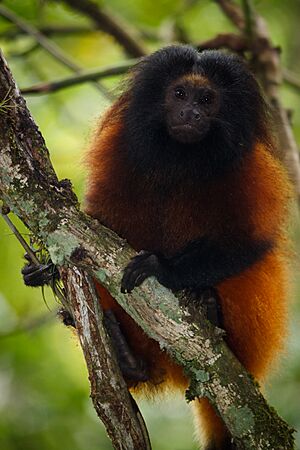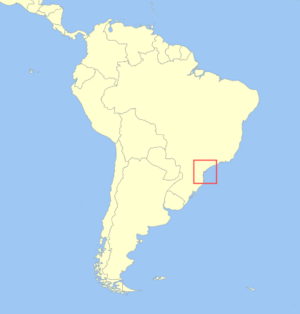Superagüi lion tamarin facts for kids
Quick facts for kids Superagüi lion tamarin |
|
|---|---|
 |
|
| Conservation status | |
| Scientific classification | |
| Genus: |
Leontopithecus
|
| Species: |
caissara
|
 |
|
| Geographic range | |
The black-faced lion tamarin, also known as the Superagüi lion tamarin (Leontopithecus caissara), is a small monkey. It belongs to a group called New World monkeys. These monkeys live only in the Americas.
This special animal is found only in the coastal forests of southeastern Brazil. It is an endangered species. This means there are very few left in the wild. Scientists believe there are fewer than 400 of these tamarins alive.
The Superagüi lion tamarin is easy to spot. Its body is a bright golden-orange color. But its head, legs, and tail are black. This makes it look very unique!
Scientists first officially described this tamarin in 1990. Two Brazilian researchers, Maria Lucia Lorini and Vanessa Persson, found them. They saw these monkeys on Superagui Island in Brazil. Soon after, more groups were found nearby on the mainland. The name caissara honors the local people of Superagui Island.
These tamarins like to live in wet, swampy forests. They also live in tall coastal forests. They always stay in areas that are less than 40 meters (about 130 feet) above sea level.
Contents
What They Eat and How They Live
The black-faced lion tamarin spends most of its life in trees. This is called being arboreal. They mostly eat small fruits. They also enjoy eating invertebrates. These include insects, spiders, and snails.
Sometimes, they drink sweet nectar from flowers. They also eat young leaves from plants called bromeliads. During the dry season, they might eat mushrooms to help their diet.
These tamarins live in family groups. A group usually has 2 to 8 members. These are often extended families. In most groups, only one female has babies each season. They usually give birth to twins. This happens between September and March.
Family members often groom each other. This means they clean each other's fur. Grooming helps them stay close. It is an important way they show affection.
Protecting the Superagüi Lion Tamarin
Why They Are in Danger
The Superagüi lion tamarin is in great danger. There are only about 400 of them left. About half of these are adults. They need a very specific type of forest to live in.
The biggest threat to them is losing their home. Forests are being cut down for farms and buildings. This also breaks up their habitat into smaller pieces. People also cut down palm trees for "heart-of-palm." This destroys more of their forest home.
Other dangers include people illegally catching them for pets. Hunting is also a problem. More tourists can disturb them too. Sometimes, animals in small groups can have problems with inbreeding depression. This means they are too closely related.
How We Are Helping
Many groups are working to protect these tamarins. The IUCN lists them as endangered. They are also on the Endangered Species Act. This law helps protect species in the United States. They are also listed on CITES Appendix I. This international agreement controls trade of endangered animals. Brazil also has its own lists to protect them.
Much of their home is protected in Superagüi National Park. This park covers Superagui Island and nearby mainland areas. It is a large park, over 33,000 hectares. The tamarins are a key species for managing the park. Another group of tamarins lives in Jacupiranga State Park in São Paulo.
The Instituto de Pesquisas Ecológicas (IPÊ) started a conservation program in 1996. They first studied the tamarins to learn about their lives. By 2005, they had enough information. They then created a plan to save the tamarins and their habitat.
IPÊ also studied the threats to the tamarins. In 2009, they held a workshop. This workshop taught people about sustainable ways to live. It helped them understand how to protect the forest. Now, IPÊ is working on new goals. They are studying how young tamarins move to new areas. They are also looking at how climate change might affect them. They also promote ways to harvest heart-of-palm without harming the forest.


